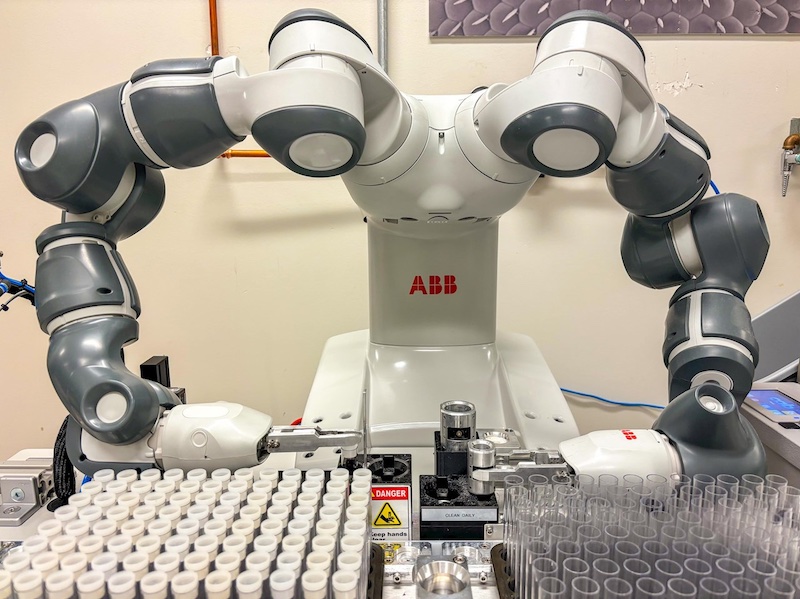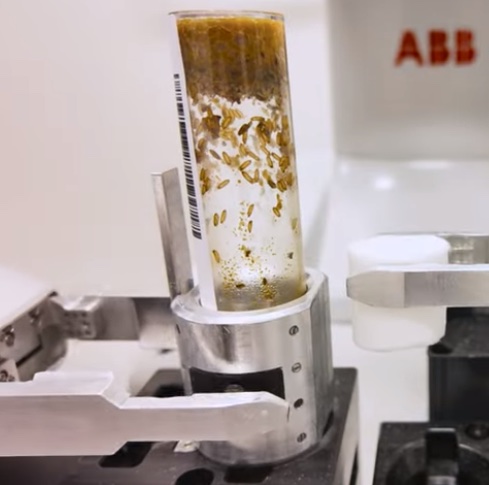Free to Fly: ABB YuMi Cobots Free Researchers to Study Disease Treatments
Duncan NRI has begun using an ABB YuMi cobot to automate maintenance tasks on fruit flies, saving 20% of the time required for medical research.
Jan and Dan Duncan Neurological Research Institute (Duncan NRI) recently turned to an unusual laboratory assistant for performing experiments in their laboratories. They automated several key maintenance tasks with an ABB YuMi cobot, which has two independently driven arms that can perform precise motions repeatedly.
The cobot frees up researchers' time and energy so they can use their brains rather than their muscles. Duncan NRI will ultimately use their findings to support the treatment of diseases at the Texas Children’s Hospital.

ABB’s YuMi cobot performing fruit fly transfers. Image used courtesy of ABB
What is Special About Fruit Flies?
Drosophila melanogaster, or the common fruit fly, shares a number of common genetic markers with humans. This makes the fruit fly a well-established choice for medical research, particularly for neurological disorders such as Alzheimer’s, Huntington’s, and Parkinson’s. Fruit flies are often used as test subjects for new medications and treatments for some of these disorders as well.
Flipping Flies
Researchers estimate that a full 20% of their time is spent maintaining the population of fruit flies. Fruit flies must be transferred between vials for feeding, living, and experimental tasks. In order to perform this step, fruit flies must be either exposed to the outside world or sedated. If the fruit flies are exposed, it can introduce contaminants and allow some fruit flies to escape.
To prevent this, the fruit flies are often temporarily sedated with carbon dioxide (CO2) so that they can be dumped between vials. This operation must occur every 30 days and may involve 20,000 vials for a modern study.
Sedation adds another level of complexity. CO2 must be administered to the fruit flies in a controlled manner, and its effects on the fruit flies, long term, is not well understood. Therefore, it is unclear as to whether the repeated sedation could affect the neurological health of the fruit flies, potentially limiting their usefulness in research.
Role of the YuMi
Perhaps YuMi’s most unique use case is in the biomedical research industry, transferring fruit flies between vials. The YuMi cobot has two multi-axis, independent arms. They can use one arm to hold a vial and tap it into the vial held by the other arm. The robot ensures proper alignment between vials, leaving them no path to escape. Furthermore, it has the endurance and the patience (unlike laboratory technicians) to perform this task 20,000 times over once a month.

One manipulator holds the vial in place while it is tapped repeatedly to remove the fruit flies. Image used courtesy of ABB
The YuMi cobot manages all of these vials with a built-in barcode reader. This way, the robot knows which vials have food, which flies need to be fed, etc. Barcodes can also be developed, and vials can be labeled, all courtesy of the YuMi cobot.
What’s Next?
Through the clever use of robotics, valuable research time is spent performing actual research instead of maintaining fruit fly populations. This is one example of a repetitive task that is much more suited for automation than human labor, and there are likely more maintenance tasks that can be automated. Ultimately, the ABB YuMi cobot will save both time and resources by transferring fruit flies without the need to expose them to CO2 or risk their escape.
Featured image used courtesy of ABB

 Facebook
Facebook Google
Google GitHub
GitHub Linkedin
Linkedin








